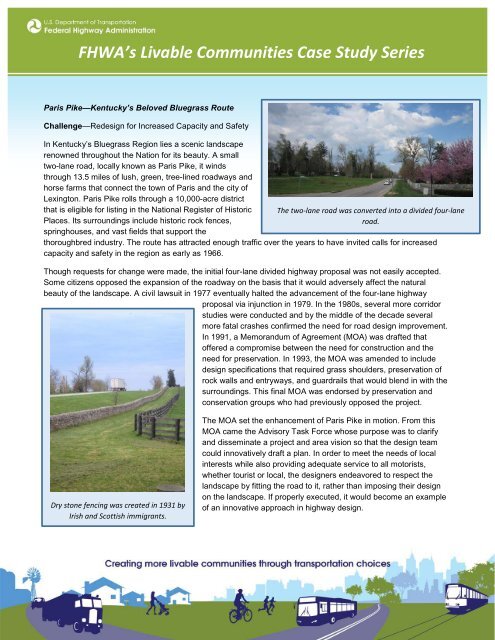Paris Pike-Kentucky's Beloved Bluegrass Route - Federal Highway ...
Paris Pike-Kentucky's Beloved Bluegrass Route - Federal Highway ...
Paris Pike-Kentucky's Beloved Bluegrass Route - Federal Highway ...
Create successful ePaper yourself
Turn your PDF publications into a flip-book with our unique Google optimized e-Paper software.
FHWA’s Livable Communities Case Study Series<br />
<strong>Paris</strong> <strong>Pike</strong>—Kentucky’s <strong>Beloved</strong> <strong>Bluegrass</strong> <strong>Route</strong><br />
Challenge—Redesign for Increased Capacity and Safety<br />
In Kentucky’s <strong>Bluegrass</strong> Region lies a scenic landscape<br />
renowned throughout the Nation for its beauty. A small<br />
two-lane road, locally known as <strong>Paris</strong> <strong>Pike</strong>, it winds<br />
through 13.5 miles of lush, green, tree-lined roadways and<br />
horse farms that connect the town of <strong>Paris</strong> and the city of<br />
Lexington. <strong>Paris</strong> <strong>Pike</strong> rolls through a 10,000-acre district<br />
that is eligible for listing in the National Register of Historic<br />
Places. Its surroundings include historic rock fences,<br />
springhouses, and vast fields that support the<br />
The two-lane road was converted into a divided four-lane<br />
road.<br />
thoroughbred industry. The route has attracted enough traffic over the years to have invited calls for increased<br />
capacity and safety in the region as early as 1966.<br />
Though requests for change were made, the initial four-lane divided highway proposal was not easily accepted.<br />
Some citizens opposed the expansion of the roadway on the basis that it would adversely affect the natural<br />
beauty of the landscape. A civil lawsuit in 1977 eventually halted the advancement of the four-lane highway<br />
proposal via injunction in 1979. In the 1980s, several more corridor<br />
studies were conducted and by the middle of the decade several<br />
more fatal crashes confirmed the need for road design improvement.<br />
In 1991, a Memorandum of Agreement (MOA) was drafted that<br />
offered a compromise between the need for construction and the<br />
need for preservation. In 1993, the MOA was amended to include<br />
design specifications that required grass shoulders, preservation of<br />
rock walls and entryways, and guardrails that would blend in with the<br />
surroundings. This final MOA was endorsed by preservation and<br />
conservation groups who had previously opposed the project.<br />
Dry stone fencing was created in 1931 by<br />
Irish and Scottish immigrants.<br />
The MOA set the enhancement of <strong>Paris</strong> <strong>Pike</strong> in motion. From this<br />
MOA came the Advisory Task Force whose purpose was to clarify<br />
and disseminate a project and area vision so that the design team<br />
could innovatively draft a plan. In order to meet the needs of local<br />
interests while also providing adequate service to all motorists,<br />
whether tourist or local, the designers endeavored to respect the<br />
landscape by fitting the road to it, rather than imposing their design<br />
on the landscape. If properly executed, it would become an example<br />
of an innovative approach in highway design.
Solution—Letting the Land Lead Design<br />
Under the premise that the landscape provided a blueprint for gateways<br />
to cultural, historic, scenic, natural, archaeological, and recreational<br />
amenities, the design followed the landscape’s lead. Though the overall<br />
project cost more than others of similar capacity and purpose due to the<br />
imperative to protect the corridor’s historic nature, opportunities to save<br />
money were seized. By opting to not to destroy the rolling hills and<br />
curve around them instead, earthwork costs were considerably<br />
reduced. Avoiding the costs of cut and fill engendered a design that<br />
offered rounded side slopes for smooth, scenic, and safe navigation of<br />
the roadway.<br />
Rusted guardrails were used to blend in<br />
with the countryside.<br />
Keeping the community and various stakeholders involved throughout<br />
the process was crucial in establishing a mutually acceptable result.<br />
Public participation was encouraged through citizen task force meetings, property owner workshops, and monthly<br />
newsletters. In addition, designers provided key visualization tools such as three-dimensional models of roadway<br />
designs and interactive techniques, such as electronic polling for community input on design issues.<br />
Funding—Establishing Effective and Sustainable<br />
Work<br />
A variety of historic fences line the road.<br />
The total project cost of $108 million was<br />
77 percent federally funded through the National<br />
<strong>Highway</strong> System program. Kentucky’s dedicated<br />
road fund provided the match. An additional<br />
$60,000 came from Transportation Enhancement<br />
(TE) funds. TE funds provided training for<br />
stonemasons performing the rock fence relocation<br />
portion of the project. Thus, in addition to the<br />
overall success of the project, there are now<br />
several more stonewall masons certified as well as<br />
specifications developed during the project that can<br />
be applied by transportation departments<br />
throughout the Nation.<br />
Results—Positive End to Decades-Old Attempts<br />
In 2003, when the <strong>Pike</strong> was completed, it was projected that traffic volume would triple by 2020. Such a prospect<br />
inspired the development of a roadway design that could accommodate that increase without sacrificing the<br />
beautiful views of the countryside. Community involvement throughout the design and construction process<br />
helped to ease decades-old tensions that had impeded the progress of a necessary new vision. The <strong>Paris</strong> <strong>Pike</strong><br />
project won a 2002 Merit-Design award from the American Society of Landscape Architects, the <strong>Federal</strong> <strong>Highway</strong><br />
Administration’s Environmental Excellence Award, and the 2003 National Partnership for <strong>Highway</strong> Quality State<br />
Award.
















